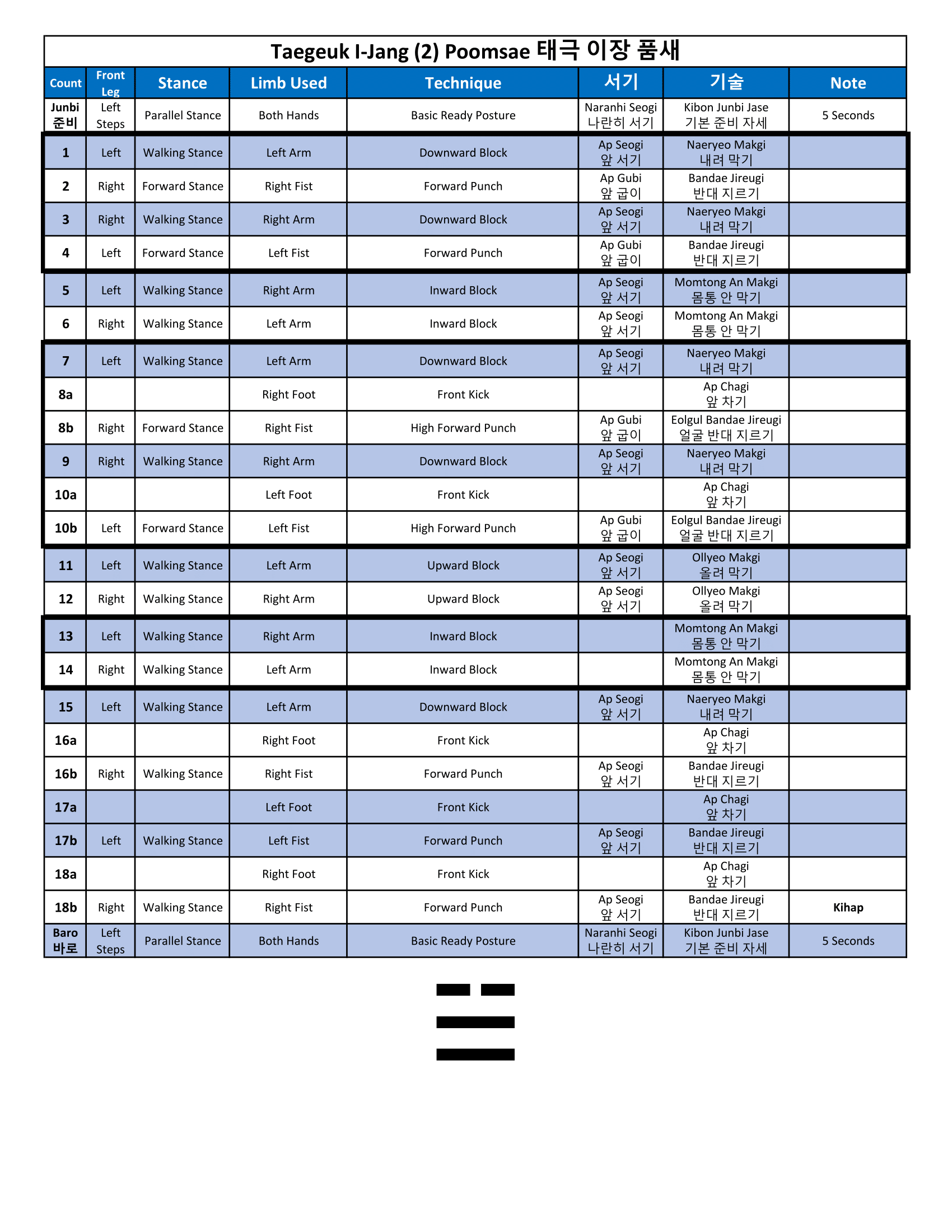Taegeuk I-Jang
태극 이장
Taegeuk 2
“Teyh-Goog Ee-Jahng”
7th Geup Poomsae
Trigram: ☱ Lake
Taegeuk 2-Jang symbolizes 태 Tae (澤) in Palgwae. “Tae” in this instance doesn’t refer to destroying something with your foot as in the word Taekwondo, but literally means a pond or lake with a calm surface. Applied to the human body, it means controlling breath and further, emotions. While practicing the Poomsae, you need to concentrate your physical energy on your 단전 danjeon (lower abdomen) without making any wasted movements. Irrespective of acquiring technique, using them for precise attack and defense is difficult without controlling breathing and emotions. Thus, the practitioner should train Poomsae like a pond with a calm surface but with depth, and achieve a state of “an iron fist in a velvet glove”.
“Taegeuk 2-Jang has almost the same set of techniques as Taegeuk 1-Jang. However, while Taegeuk 1-Jang delivers force by maintaining the height in 앞 서기 Ap Seogi (Walking Stance), Taegeuk 2-Jang embodies how to create force in 앞 서기 Ap Seogi by lowering the center of gravity using 앞 굽이 Ap Gubi (Forward Stance) and 얼굴 반대 지르기 Eolgul Bandae Jireugi (High Forward Punch) techniques, and weight by stabilizing the shoulders and shoulder blades. Also, the practitioner must practice connecting a series of left and right 앞 차기 Ap Chagi and 지르기 Jireugi more systematically.”
Side-To-Side Turn 1: Front Foot Dorsal Turn
Side-To-Side Turn 2: Front Foot Dorsal Turn
Side-To-Side Turn 3: Back Foot Ventral Turn
Technique Summary
서기 Stances:
Closed Stance / Moa Seogi / 모아 서기
Parallel Stance / Naranhi Seogi / 나란히 서기
Walking Stance / Ap Seogi / 앞 서기
Forward Stance / Ap Gubi / 앞 굽이
방어 기술 Defensive Skills:
Downward Block / Naeryeo Makgi / 내려 막기
Middle Inward Block / Momtong An Makgi / 몸통 안 막기
Upward Block / Ollyeo Makgi / 올려 막기
공격 기술 Offensive Skills:
Forward Punch / Bandae Jireugi / 반대 지르기
High Forward Punch / Eolgul Bandae Jireugi / 얼굴 반대 지르기
Front Kick / Ap Chagi / 앞 차기
특수품 Special Skills:
Basic Ready Posture / Kibon Junbi Jase / 기본 준비 자세 (5 Seconds)
기합 Kihap:
On the final Forward Punch
Performance Notes
Rhythm / Tempo:
Be mindful of the different intervals between movements, which are determined by whether or not the next technique is offensive or defensive.Walking Stance → Forward Stance:
Make sure you are driving the rear foot hard into the floor when moving from stance to stance.High Forward Punch (1st Position):
Make sure that the Pulling Hand extends to philtrim height.High Forward Punch (2nd Position):
The punch should end at philtrum (between the nose and upper lip) height.


